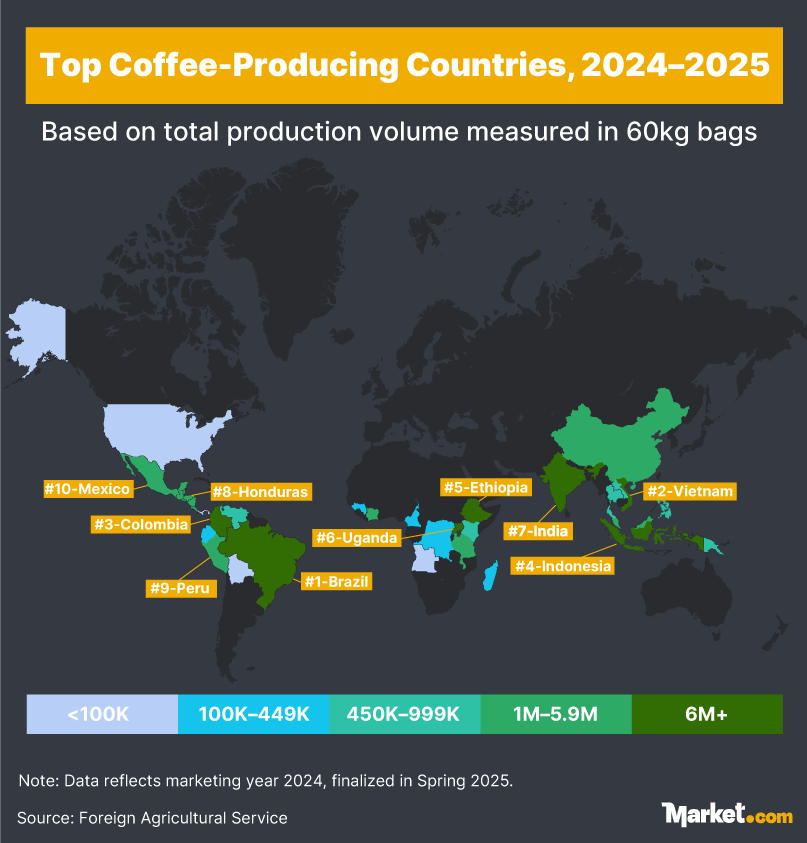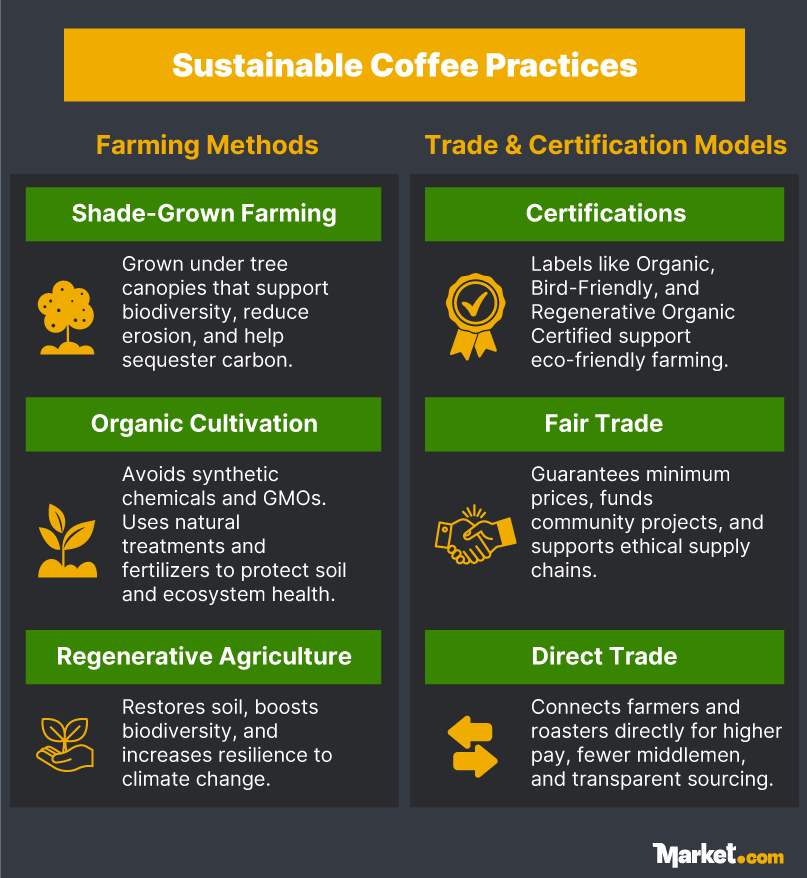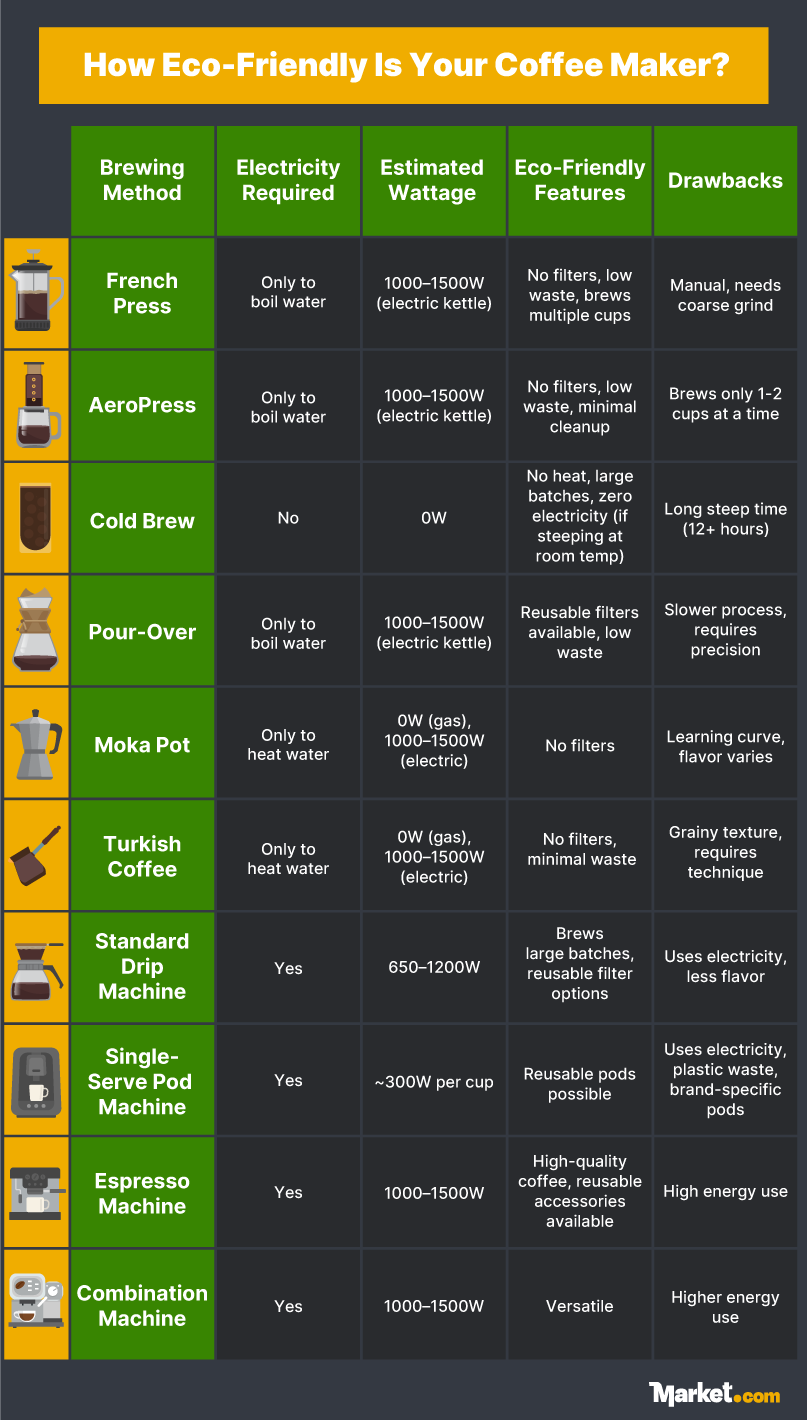Coffee consumption is at an all-time high. Globally, we drink more than 2.25 billion cups each day. In the United States, roughly 66% of Americans drink coffee every day, making it even more popular than tap water.
But rising demand comes with environmental costs. Coffee production contributes to deforestation, water pollution, and greenhouse gas emissions. At-home brewing habits matter too, with disposable cups, single-use pods, and energy-intensive machines all adding to the industry’s footprint.
This guide outlines clear steps you can take to make your coffee routine more sustainable. It covers how to choose responsible coffee beans, reduce waste at home, and select efficient brewing equipment. Small changes, when done at scale, can make a measurable difference.
Where Does the Best Coffee Come From?
Coffee comes from the Coffea plant, a tropical shrub that grows best in warm, humid climates. It’s cultivated in more than 70 countries, mainly in a region called the “coffee belt,” a zone centered around the equator that stretches through Central and South America, Africa, the Middle East, and Southeast Asia, where the climate is just right for coffee to thrive.

The best beans usually grow at high elevations (typically 1,000–2,000 meters, or 3,200–6,500 feet, above sea level), with mild temperatures between 64°F and 70°F (18°C and 21°C), consistent rainfall, and rich volcanic or loamy soil. These ideal conditions are found in mountainous regions of countries like Brazil, Colombia, Ethiopia, and Guatemala.
Cooler temperatures at higher elevations slow the ripening of coffee cherries, giving the beans time to develop deeper, more complex flavors. Coffee plants also tend to produce less caffeine at higher altitudes, since caffeine acts as a natural defense against insects, and there are fewer pests in cooler, highland environments. High-altitude farming can also be more sustainable, especially when coffee is grown under natural shade that helps preserve biodiversity and reduce the use of chemicals.
Coffee Bean Varieties
The global coffee market is dominated by two types of beans: Arabica and Robusta. Arabica makes up almost 60% of the world’s coffee and is known for its smooth, often fruity or floral flavor. Between these two varieties, Arabica is more delicate and grows best at higher altitudes. It’s also increasingly vulnerable to climate change, with some experts warning that the land suitable for growing Arabica could shrink by as much as 80% by 2050.
Robusta, on the other hand, grows in lower, hotter regions and is more resistant to pests and disease. It has a stronger, more bitter taste and nearly double the caffeine of Arabica. And true to its name, Robusta is naturally more “robust” in the face of climate stress. It’s more adaptable to fluctuating conditions and continues to produce high yields where Arabica struggles.
Brazil is the world’s largest coffee producer, responsible for about a third of the global supply. With over two million hectares dedicated to coffee farming, it produces around 43 million 60kg bags annually, 70% of which is Arabica.
Colombia and Ethiopia also specialize in Arabica, each offering unique taste profiles shaped by regional climate, altitude, and soil. Vietnam, the second-largest coffee producer globally, focuses primarily on Robusta and has expanded its production rapidly over the last few decades.
While Arabica and Robusta dominate today’s market, a third variety, Liberica, once accounted for nearly half of the world’s supply before falling out of mass production. Grown mainly in Malaysia and the Philippines today, Liberica is known for its woody, sometimes fruity flavor and more polarizing taste, and now makes up less than 1% of global coffee.
Each bean plays a different role in the cup, influencing both the flavor and preparation style of the coffee being made. Arabica beans are typically used in black coffee, Americanos, and pour-over brews, where their subtle flavors can stand out. Robusta beans, with their bold profile and thick crema, can be favored for espresso-based drinks like cappuccinos, lattes, and mochas. You can also usually find blends, meaning your drink will have a bit of both.
These specialty coffee drinks are increasingly popular. According to the National Coffee Association’s 2024 report, 45% of American adults drank specialty coffee the day before the survey, surpassing traditional coffee for the first time and marking an 80% increase since 2011.
Many of these drinks trace their roots back to European café culture, particularly in Italy, where espresso-based beverages first gained popularity.
What Is Sustainable Coffee, and Why Should You Drink It?
Coffee production has a real impact on people and the planet, and not always for the better. Traditional coffee farming is a major driver of deforestation, biodiversity loss, and water pollution.
Clearing forests to plant sun-grown coffee reduces wildlife habitats and increases greenhouse gas emissions. Chemical fertilizers and pesticides used in non-organic farming can also contaminate waterways and degrade soil.
Coffee production alone contributes between 40–80% of the industry’s total carbon footprint. In fact, coffee has the second-highest carbon footprint among plant-based foods, just after chocolate, generating an estimated 17 kg of greenhouse gas emissions per 1 kg of coffee. At the industry level, coffee production emits roughly 863 to 894 kilotonnes of CO₂ equivalents each year.
The human cost is just as steep. According to Fairtrade, around 125 million people rely on coffee for their livelihoods, but most of the world’s 25 million smallholder farmers, who grow 80% of the world’s coffee, struggle to earn a stable living. Nearly half live below the international poverty line. Meanwhile, most of the value in the global coffee trade is captured by wealthier countries like the U.S. and Switzerland, where beans are processed, branded, and sold at a premium.

Sustainable coffee aims to reduce environmental harm while supporting farmers and ecosystems. Several farming methods and trade models are leading the change:
- Shade-grown farming: Coffee grown under tree canopies supports biodiversity, reduces erosion, retains water, and sequesters carbon. It typically requires fewer chemicals but may result in lower yields.
- Organic cultivation: This method avoids synthetic pesticides, fertilizers, and GMOs. Instead, it relies on natural treatments and fertilizers, as well as crop rotation, to protect soil health and biodiversity. Certified organic farms must meet strict environmental standards.
- Regenerative agriculture: Goes beyond sustainability by actively restoring ecosystems. It emphasizes soil enrichment, carbon capture, and climate resilience through practices that improve long-term land health.
- Certifications: Look for labels like Organic, Bird-Friendly, and Regenerative Organic Certified when buying coffee. These certifications signal that beans were grown using environmentally responsible practices and help ensure transparency.
- Fair and direct trade: Both models aim to improve farmer compensation and working conditions. Fair trade sets minimum prices and funds community projects, while direct trade creates more transparent relationships between producers and buyers, which often results in higher incomes and fewer middlemen.
Still, change isn’t easy. Shifting to organic farming, for example, often leads to lower short-term yields and higher costs. Many farmers need outside support to make this transition realistic and sustainable in the long run.
There are signs of progress, though. According to a report from the Sustainable Coffee Challenge, 65% of industry stakeholders have made progress toward sustainability goals, and 81% of efforts align with 2025 targets. Regulations are slowly replacing voluntary commitments, and consumer demand for ethical coffee is pushing the industry forward.
How to Make Your Coffee Routine More Sustainable
Making your coffee more sustainable doesn’t require a full lifestyle overhaul, just a few smart changes to your daily routine. With 81% of American coffee drinkers brewing coffee at home, these small adjustments can add up to a big impact.
Choose Sustainable Coffee Beans
If you want your coffee habit to support the planet and farmers, the best place to start is with the beans. As we’ve said, coffee production makes up as much as 80% of the industry’s total carbon footprint.
For coffee producers, while sustainable farming can be challenging to implement, studies show it can pay off long-term. One found that people are willing to pay $1.36 more per pound of coffee that’s produced in an ethical and eco-friendly way.
Skip Instant Coffee
Instant coffee may be convenient, but it comes with a high environmental cost. Producing it requires more than double the number of coffee beans and up to 11 times more energy than ground coffee, according to a 2023 study on the sustainability of coffee production. The additional processing steps, like extraction, evaporation, and drying, are resource-intensive and drive up both emissions and production costs.
Packaging is also a problem. Instant coffee is typically sold in glass jars, which although highly recyclable, are heavier, harder to produce, and more carbon-intensive than laminated pouches. The study found that packaging alone accounts for over half of instant coffee’s life-cycle cost, compared to just a quarter for ground coffee.
Choosing whole or ground beans is a better alternative to instant coffee.
Look for Trusted Certifications
Labels like Fair Trade, Rainforest Alliance, and Organic Certified signal efforts to ensure ethical sourcing, fair pay, and environmentally friendly farming. Fair Trade, for example, guarantees a minimum price for farmers and has delivered over $1 billion in benefits to workers since 1998. Rainforest Alliance-certified farms focus on biodiversity and forest conservation, while Organic certification means the coffee was grown without synthetic pesticides or fertilizers.
But not all certifications are foolproof. Greenwashing, when brands exaggerate or misrepresent their sustainability efforts, is common in the coffee industry. One example is the repeated setting and shifting of targets around single-use plastic bans. In 2019, Starbucks walked back its pledge to make all takeaway cups recyclable or reusable. Moves like this can make a brand appear committed to sustainability while avoiding meaningful change.
Even third-party certifications can miss the mark if oversight is weak; transparency and traceability matter just as much as logos on a bag.
Support Direct-Trade and Local Roasters
Buying coffee directly from small, ethical producers can reduce emissions tied to complex global supply chains, promote transparency, and ensure more of the profits go to the farmers.
Some brands are built entirely around this model, including:
- Tiny Footprint Coffee: The world’s first carbon-negative coffee company. It offsets its impact by funding reforestation projects in Ecuador for every pound of coffee sold.
- Pachamama Coffee: A farmer-owned cooperative that produces organic, shade-grown beans. Profits go directly back to smallholder growers.
- Kicking Horse Coffee: Widely available in grocery stores, this brand sources only Fairtrade, organic-certified beans from small farms and supports sustainable agriculture throughout its supply chain.
Direct-trade sourcing also tends to lead to better-quality coffee and stronger long-term relationships between roasters and producers. For consumers, it offers a more traceable, trustworthy way to support ethical farming, without relying solely on certification logos.
Opt for Shade-Grown Coffee
Unlike sun-grown coffee, which often requires deforestation and heavy chemical use, shade-grown coffee supports biodiversity and healthier ecosystems.
Farms that follow this model can store significantly more carbon than full-sun operations and support 30% more bird species. They also help control pests naturally through larger populations of birds and bats, and reduce the spread of diseases like coffee leaf rust by maintaining cooler growing conditions. Certain types of shade-grown farming mimic natural forests and allow farmers to grow other crops, boosting food security and income.
Shade-grown beans also tend to ripen more slowly, enhancing natural sugars and producing a smoother, more complex flavor. Look for Bird Friendly or Shade Grown certifications to ensure your coffee was grown under these conditions.
While no single certification or brand guarantees perfection, choosing beans from transparent, sustainable sources is a meaningful step toward a coffee industry that works better for everyone.
Reduce Waste in Your Coffee Routine
Even the most sustainably grown coffee can come with a heavy environmental cost if your daily routine creates unnecessary waste. A few simple swaps can make a big difference.
Ditch Single-Use Pods
Single-use coffee pods may offer convenience, but they come at a serious environmental cost. Around 20 billion pods are discarded globally each year — enough to circle the Earth 14 times. Most are made from a mix of plastic and aluminum, which can take 150 to 500 years to break down in a landfill. Recycling is also difficult; many pod systems are brand-specific and not universally accepted by recycling programs.
“Coffee pods are one of the best examples of unnecessary single-use plastics that are polluting our planet,” says John Hocevar, campaign director at Greenpeace USA. “Many end up getting incinerated, dumping poison into our air, water, and our soil.”
If you already use a pod machine, switch to refillable pods to reduce waste. But the most sustainable option is to avoid pods altogether. A pod-free coffee maker gives you more control over your brew and creates significantly less long-term waste.
Compost or Repurpose Coffee Grounds
Used coffee grounds don’t belong in the trash. They’re rich in nitrogen and ideal for composting, helping improve soil structure and attract beneficial microbes that break down organic matter. Just be sure to use them in moderation to avoid excess acidity.
Coffee grounds can also be reused in creative ways:
- As a garden fertilizer or pest repellent
- To neutralize odors in fridges, shoes, or gym bags
- As a natural scrub for cleaning or skin exfoliation
- As a DIY dye for fabrics or paper
Bring a Reusable Cup
Similar to the single-use pods, disposable cups are convenient but costly for the environment. Nearly 50 billion paper cups are discarded each year in the U.S. alone, effectively wasting the over 10 billion gallons of water they took to produce. Most have a plastic lining that makes them difficult to recycle, and improper disposal harms ecosystems by contributing to land and ocean pollution. Each single-use cup produces around 60 g of CO₂ across its entire lifecycle.
Switching to a reusable cup cuts this waste almost entirely. Many major coffee chains, including Starbucks and Costa Coffee, offer discounts or incentives when you bring your own. Reusable cups also keep drinks hotter for longer and reduce the off-taste that sometimes comes with disposable materials.
Choose Better Packaging
Coffee packaging makes up 3–5% of its carbon footprint throughout its production cycle, and most coffee bags aren’t as “green” as they seem. Even options made from kraft paper or rice paper often contain non-biodegradable inner linings, degassing valves, and sealing strips that prevent full breakdown. In fact, only about 60% of the material in these bags will decompose — the rest must be separated and properly discarded.
Truly sustainable packaging considers the full lifecycle of the material: how it’s sourced, produced, and disposed of. While newer alternatives like cornstarch and cellulose are being explored, fully biodegradable or compostable packaging still isn’t widely available. Many brands use eco-friendly language in their marketing, but the reality is more complex and often less sustainable than advertised.
Use Sustainable Brewing and Accessories
How coffee is brewed at home has its own environmental impact. While automatic drip machines remain the most popular coffee brewing method for home use in the U.S., each method has a different energy footprint and waste output. Choosing more efficient brewing methods, eco-friendly machines, and reusable accessories can reduce waste and lower your household emissions.
Choose an Energy-Efficient Brewing Method
Some brewing methods use far more electricity than others. Espresso machines, for example, draw 1000–1500 watts and consume more energy than most alternatives. Standard drip machines use less, but many models stay heated for hours, which adds up. Single-serve pod machines require only 300 watts per cup, yet still contribute significantly to waste due to their reliance on disposable plastic pods.
Manual methods are typically the most sustainable. The French press, AeroPress, pour-over, moka pot, Turkish brew, and cold brew require no electricity beyond boiling water. Cold brew, for instance, can be steeped at room temperature and stored in the fridge, allowing you to make large batches with zero heat. These low-energy options reduce emissions and eliminate the need for disposable filters or single-use parts.

Eco-Friendly Coffee Machine Features
For those who prefer electric brewing methods, choosing a more sustainable coffee machine can reduce your long-term environmental impact. While total electricity use (measured in kWh) is what matters most, machines with higher wattage often draw more power while operating, and over time, this can add up. Look for models with the following features:
- Energy efficiency: Energy-efficient machines reduce electricity use. Standard espresso machines can consume up to 1500 watts, much of it from staying heated or in standby mode. But high-efficiency models, with insulation and auto shut-off features, can cut this down to just 50 kWh per year, or even less for capsule machines. That’s a potential annual savings of 120 kWh per machine compared to conventional models.
- Water conservation: Some machines come equipped with programmable brew volumes and integrated water filters, helping to minimize water waste. Choosing a machine that uses only the amount of water needed for brewing, rather than keeping a heated reservoir, can also lower overall usage.
- Durable design: Coffee makers that are built to last reduce the need for frequent replacements and help limit e-waste. Look for machines with modular parts or extended warranties. Some brands, like KRUPS, support repairs for up to 15 years. Others, like Moccamaster, are known for long lifespans, simple designs, and user-replaceable components, letting you swap out individual parts without special tools.
- Reusable filters and pods: To cut down on disposable waste, look for machines compatible with reusable metal or cloth filters. These reduce reliance on bleached paper filters, which often contain chemical treatments. For single-serve brewers, opt for refillable pods made of stainless steel or BPA-free plastic.
- Certifications: Energy Star-certified coffee machines meet verified efficiency standards and are less wasteful over time, using 35% less energy on average than standard models. Over their lifespan, this can translate into reduced carbon emissions and hundreds of dollars in energy savings.
Selecting a sustainable brewing method and an eco-friendly coffee machine can significantly reduce the environmental cost of your daily cup of coffee.
Conclusion
Making your coffee habit more sustainable doesn’t require a complete lifestyle change. It starts with small, informed choices.
Prioritize beans that are ethically sourced, and look for trusted certifications, direct trade models, or shade-grown practices that protect both people and ecosystems. Reduce everyday waste by switching to reusable cups, composting coffee grounds, and avoiding single-use pods. If you use a coffee machine, choose one that’s energy-efficient, long-lasting, and compatible with reusable filters or pods.
Every step in the coffee process, from farming to brewing, has an environmental cost. But with thoughtful adjustments, that cost can be reduced. Whether you’re buying beans or choosing a brewing method, opt for options that reflect your sustainability goals. Over time, those decisions add up.



